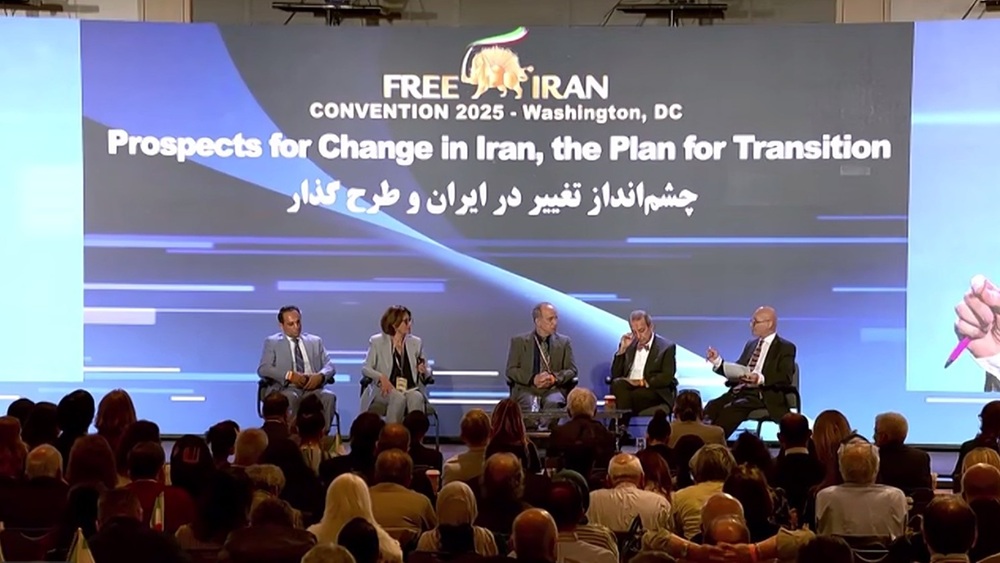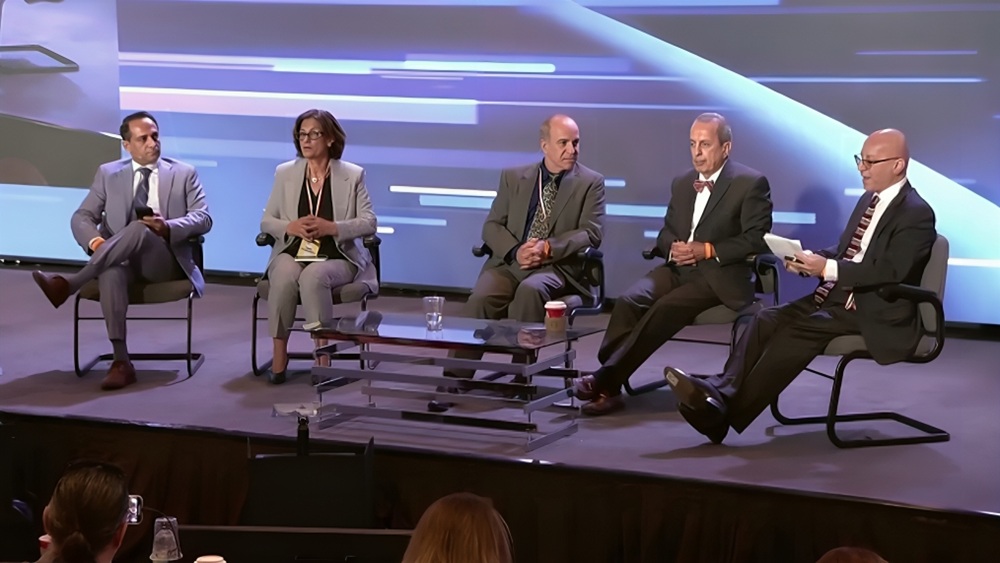
WASHINGTON, DC — The third session of the Free Iran Convention 2025 returned to one of the central questions of the entire gathering: How does Iran move from a collapsing dictatorship to a stable, democratic republic? Panel Five, titled “Prospects for Change in Iran: The Plan for Transition,” brought together accomplished voices in medicine, software engineering, aerospace innovation, robotics, and political research. Their task was twofold: to examine the strategy capable of delivering the final blow to a regime in terminal crisis, and to outline how Iran can achieve a peaceful, democratic transition after the fall of the clerical establishment.
Panel moderator Dr. Saeid Sajadi opened the discussion by saluting the earlier panels—women, scholars, and youth—for laying out the forces driving Iran toward change. Sajadi, an internal medicine specialist and researcher at Harvard University, framed the transition debate with both historical clarity and present urgency.
He recalled June 20, 1981, when Khomeini ordered the IRGC to open fire on a peaceful rally of half a million MEK supporters—an event he described as the moment the regime “lost the very last vestiges of political legitimacy.” The resistance, he noted, stood alone in those early years, confronting a system built on theocratic absolutism and violence.
Sajadi argued that decades of experience—and successive waves of uprisings—have proven that meaningful reform is impossible under a constitution that enshrines the Supreme Leader as the representative of God on earth. Both factions of the regime, he said, “have pursued the same policies of repression at home and terrorism abroad,” rendering the notion of moderation a political illusion.
Today, Sajadi stated, the regime is “engulfed in a terminal crisis… too fragile to retreat and unable to move forward.” The fall is inevitable; the question is how it will occur and how Iran will transition. This panel, he said, would address both: the strategy to topple the regime and the roadmap for a democratic future.
At #FreeIranConvention2025, @ShirinNariman – a former political prisoner turned human-rights advocate – opens “Voices from Iran,” sharing messages smuggled out at great personal risk from MEK prisoners, death-row inmates and @ResistanceUnits. From 1988 to Behrouz Ehsani, Mehdi… pic.twitter.com/Pq0ucwKfu4
— NCRI-U.S. Rep Office (@NCRIUS) November 15, 2025
Software engineer Farideh Sedighi opened with an unequivocal assessment: yes, regime change in Iran is not only possible—it is increasingly inevitable. She outlined three converging forces shaping this reality: the regime’s collapse from within, the determination of the Iranian people, and the existence of an organized alternative capable of leading the transition.
Sedighi described a government buckling under “four decades of repression, corruption, and a collapsing economy,” noting that 80% of Iranians now live below the poverty line while inflation continues to accelerate. Political division, she said, is hollowing out the regime’s core as Khamenei loses his grip. Regionally, Tehran’s proxies are weakened; internationally, the regime is isolated.
On the other side, she highlighted a society reaching its breaking point. Since 2017, each nationwide uprising has grown stronger, culminating in the powerful 2019 and 2022 movements led by women and youth. In the last year alone, she emphasized, over 3,000 protests across 16 sectors show a population unified in demanding change and rejecting all factions of the regime, including so-called reformists.
But Sedighi stressed that uprisings alone cannot topple the dictatorship. “We need leadership and organization,” she said—and those exist in Maryam Rajavi, the NCRI, and the MEK. She emphasized the rapid expansion of MEK Resistance Units, citing 3,000 operations and 40,000 symbolic acts across 135 cities in the past year. Their disciplined growth, she concluded, “is why regime change is real, within reach, and driven by the courage of the Iranian people and their Organized Resistance.”
Reza Nemovi: #Iran’s youth don’t seek luxury—they seek liberty. Through unity and organized Resistance, they’ve broken every barrier. With intelligence, perseverance, and purpose, the regime is just a wall waiting to fall. #NCRIAlternative https://t.co/bs49gtUUKs
— NCRI-FAC (@iran_policy) November 15, 2025
Design engineer Reza M. Nemovi responded to the question of what Iran’s younger generations want with a deeply personal reflection, drawing parallels between his own struggle and the mindset of a new generation determined to reshape Iran’s future.
Nemovi described a youth that has grown up under repression but refuses to be defined by it—echoing the same spirit that carried him through his own near-impossible odds. He recounted surviving a catastrophic skydiving accident that left him in a coma and, according to doctors, destined for permanent disability. Yet, guided by a motto shared by his mother and echoed by Maryam Rajavi—“You can and you must”—he rejected defeat. After years in hospitals and four years in a wheelchair, he taught himself to walk again, returned to school, and ultimately became a lead engineer at Caltech designing advanced AI-based robotic systems used in aerospace exploration.
He sees Iran’s youth through the same lens: disciplined, resilient, and unbreakably committed to freedom. They are not motivated by privilege, he said, but by the desire to live in a country where creativity, equality, and free thought—not dictatorship—shape their future.
Iran’s youth, he emphasized, have rejected all forms of tyranny, “today or tomorrow.” Through unity, they have broken ethnic, gender, and class divides; through Resistance Units, they have gained strategy and courage. They understand the price of freedom, and they are willing to pay it.
“When all the right conditions exist, the outcome is inevitable,” Nemovi said. Intelligence, perseverance, purpose—“Iran’s youth already have these conditions. The regime is only a wall waiting to fall.”
.@BehzadRaofi02: Nationwide uprisings now have a new force: #MEKResistanceUnits. For over a decade they’ve grown in size and sophistication—once writing slogans on walls, now riding through Iran in broad daylight holding images #NCRIAlternative leaders.https://t.co/KRFi9QtzCC
— NCRI-FAC (@iran_policy) November 15, 2025
Q&A: Managing the Transition and Ensuring a Stable Democratic Future
The Q&A portion of Panel 5 shifted the focus from strategies to topple the regime to the critical question of what comes after. Panelists addressed concerns about stability, governance, and credibility in a post-theocracy Iran, offering evidence-based perspectives on why the transition can succeed.
In response to concerns that Iran might collapse into chaos after the fall of the regime, Farideh Sedighi firmly rejected the premise as a narrative engineered by both the current regime and the Shah before it. She emphasized Iran’s long-standing identity as a cohesive, historic nation-state with 4,000 years of cultural continuity. Sedighi reminded the audience that Iran’s ethnic and religious diversity has coexisted peacefully for centuries, and the true destabilizing force has been the regime itself—spreading extremism, fueling sectarian conflict, and empowering proxy militias.
She argued that today, the strongest unifying factor among Iranians is their shared desire to end the dictatorship. She pointed to the NCRI’s extensive nationwide network, decades of organizational continuity, and a clear political platform as the foundation for a stable transition. According to Sedighi, the presence of an organized, credible alternative means that the fall of the regime will not lead to fragmentation but to national restoration.
Turning to the question of whether the NCRI can manage the complex issues facing Iran in the six-month transitional period, Dr. Behzad Raofi drew parallels to his own work at NASA, where success depends on building complex systems through rigorous testing and coordinated planning. He explained that the NCRI has spent 44 years preparing for this moment, demonstrating resilience, structure, and strategic adaptability.
Raofi highlighted the NCRI’s 450-member coalition, composed of diverse political, ethnic, and religious representatives, noting that women make up 52% of its membership—a notable indicator of democratic values and inclusivity. He outlined how the NCRI’s 25 expert committees, functioning as ministries-in-waiting, have already developed frameworks for governance, from health and the environment to economics and justice.
He emphasized that the NCRI has survived exile, assassinations, international disinformation campaigns, and military attacks, yet has remained organizationally intact and politically consistent. This track record, he argued, is the strongest proof that it can steer Iran through a peaceful and operationally competent transition.
Asked about the enthusiasm surrounding Maryam Rajavi’s Ten-Point Plan, Reza Nemovi drew on his engineering background to explain why the plan resonates with young Iranians and professionals alike. He highlighted the importance of clear system architecture—a principle familiar to engineers—and noted that points such as the separation of religion and state and a merit-based economy create the structural stability Iran desperately needs.
Nemovi emphasized that decades of corruption and ideological governance have suffocated creativity. In contrast, Rajavi’s plan outlines a secular, transparent, innovation-driven model—one that aligns with global scientific and economic standards. He argued that this blueprint demonstrates practical foresight, restores opportunity, and reflects the aspirations of a new generation that seeks dignity, equality, and modern governance.
Confronting the lingering question of trust—especially in light of the betrayal of 1979—Dr. Firouz Daneshgari argued that credibility must rest on evidence, not promises. Drawing on his background in medicine and scientific review, he emphasized that trust is earned through decades of consistent behavior, transparency, and alignment between principles and actions.
Daneshgari noted that for over forty years, the NCRI has publicly declared its principles—democracy, gender equality, secular governance, and pluralism—and has never compromised them, despite facing assassinations, massacres, and international pressure. He encouraged attendees to examine the NCRI’s annual reports, highlighting how its analyses—from nuclear revelations in 2002 to predictions about regional terrorism—have repeatedly proven accurate.
He concluded that the NCRI’s unwavering adherence to its democratic standards, combined with its demonstrated organizational capacity, forms a credible foundation for a trustworthy transition. “Promises made, promises kept,” he said, summarizing the NCRI’s record in a single phrase.


